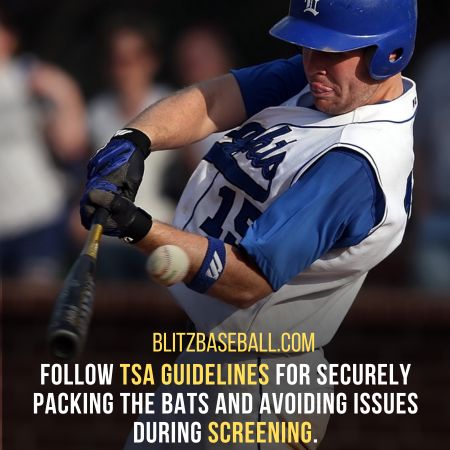Traveling with baseball bats can be a frustrating experience, as TSA laws and regulations impose specific guidelines for carrying them on airplanes.
While it is generally legal to carry baseball bats in public as long as they are packed appropriately, flying with bats requires declaring them at the airport and adhering to airline size and weight restrictions.
Furthermore, it is essential to be prepared for the possibility of damaged bats during travel.
This article explores the legality, regulations, and potential challenges of traveling with baseball bats. Let’s see are baseball bats allowed on airplanes?
Key Takeaways
- Use specialized bags designed for baseball bats for transportation.
- Declare the presence of bats at the airport and inform airline staff about their fragile nature.
- Follow TSA guidelines for securely packing the bats and avoiding issues during screening.
- In case of any damages, file a claim with the airline and document the damages with photographs, keeping all relevant receipts and documentation for the claim process.
Are Baseball Bats Allowed On Airplanes?
When traveling with baseball bats, it is important to be aware of the typical bag used for transporting them and to understand the legality of carrying them in public spaces.
Baseball bats are usually transported in specialized bags designed to protect them during travel. These bags are long and cylindrical in shape, with padding and compartments to keep the bats secure and prevent damage. It is crucial to ensure that the bag meets the size and weight restrictions of the airline you are flying with.
Additionally, it is essential to check the local laws and regulations regarding the carrying of baseball bats in public spaces. While baseball bats are generally allowed, there may be restrictions in certain areas or during certain events for safety reasons.
It is advisable to declare the baseball bats at the airport and follow any instructions given by the TSA or airline staff to ensure a smooth travel experience.

Legality and Regulations
The legality and regulations surrounding the transportation of certain sports equipment, such as baseball bats, on flights can pose challenges for travelers. It is important for individuals to familiarize themselves with the guidelines set forth by the Transportation Security Administration (TSA) to ensure a smooth travel experience.
When it comes to baseball bats, here are some key points to consider:
- Baseball bats are allowed on airplanes as checked baggage.
- Bats must be securely packed in a suitable bag or case to prevent damage.
- It is recommended to declare the presence of a baseball bat at the airport to avoid any potential issues during screening.
- In the event of a damaged bat, passengers can file a claim with the airline for compensation.
By adhering to these regulations, travelers can navigate the complexities of flying with baseball bats and ensure a hassle-free journey.
Dealing with Damages
One aspect to consider is the process for addressing any potential damages that may occur to sports equipment during air travel.
When it comes to baseball bats, it is important to take precautionary measures to protect them from being damaged. One option is to use a specialized bag designed specifically for baseball bats. These bags often have padding or compartments to keep the bats secure and prevent them from banging against each other.
Additionally, it is recommended to declare the baseball bats at the airport and inform the airline staff about the fragile nature of the equipment. In case any damages occur, it is advisable to file a claim with the airline as soon as possible.
It is also a good practice to document any damages with photographs and keep all relevant receipts and documentation for the claim process.
Overall, being proactive and taking appropriate measures can help minimize the risk of damage to baseball bats during air travel.

Frequently Asked Questions
Can I bring my baseball bat as a carry-on item on the airplane?
Baseball bats are generally not allowed as carry-on items on airplanes due to their potential use as weapons. However, they may be transported as checked baggage. It is recommended to check with the airline and follow their specific guidelines for packing and declaring bats.
Are there any restrictions on the size or weight of baseball bats that can be brought on an airplane?
There are no specific restrictions on the size or weight of baseball bats that can be brought on an airplane. However, it is advised to check with the airline regarding their policies on sporting equipment.
Are there any specific guidelines for transporting baseball bats in checked luggage?
Specific guidelines for transporting baseball bats in checked luggage vary depending on the airline and TSA regulations. It is generally recommended to pack the bat in a protective case and declare it at the airport to ensure compliance with safety regulations.
Can I bring a personalized or engraved baseball bat on an airplane?
Yes, you can bring a personalized or engraved baseball bat on an airplane. There are no specific TSA regulations that prohibit the transportation of personalized or engraved baseball bats in checked or carry-on luggage.
Are there any restrictions on the types of baseball bats that can be brought on an airplane, such as wooden bats versus aluminum bats?
Restrictions on the types of baseball bats that can be brought on an airplane vary depending on the airline and country. Some airlines may allow both wooden and aluminum bats, while others may have specific limitations. It is advisable to check with the airline before traveling.

Conclusion
In conclusion, traveling with baseball bats can be a challenging task due to TSA laws and regulations.
While it is generally legal to carry baseball bats in public, flying with them requires adherence to specific guidelines. Bats must be declared at the airport and packed appropriately.
It is also crucial to be prepared for the possibility of damaged bats during travel.
Despite these challenges, with proper preparation, it is possible to navigate the rules and regulations successfully.
